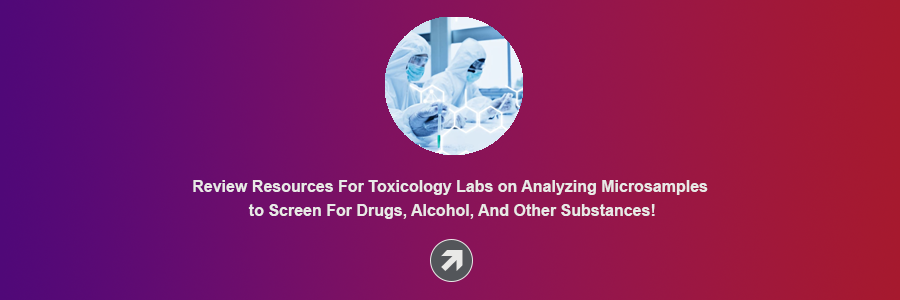Share this
VAMS for monitoring tyrosine kinase inhibitors
by James Rudge, PhD, Technical Director, Trajan on Dec 27, 2021 8:30:00 AM
An article published by Nick Verougstraete and Christophe P. Stove in the January 2022 issue of the Journal of Pharmaceutical and Biomedical Analysis, demonstrated a robust analytical validation of eight tyrosine kinase inhibitors (TKI) as potential candidates for TDM of cancer patients.
The paper is entitled “Volumetric absorptive microsampling as a suitable tool to monitor tyrosine kinase inhibitors.” It showcases development and validation of a robust extraction from samples collection on Mitra® devices based on VAMS® technology for use on a previously developed multiplex LC-MS/MS assay.
This assay was originally developed for liquid blood and plasma samples. The researchers proposed it as a possible alternative method to measure TKIs on dried blood where a previous study had shown a failure rate of 20% when dried blood spot (DBS) had been employed.
What are Tyrosine Kinase Inhibitors?
Tyrosine kinase inhibitors, or TKIs, are a class of anti-cancer drugs that target the tyrosine kinase group of enzymes, which act to phosphorylate up to 50 proteins. The phosphorylation effect acts in several ways to promote cancer formation, by switching on and off the function of certain proteins.
This leads to changes in physiological activities such as an increase in cellular influx of glucose, (the main fuel for cellular metabolism) and a reduction in cellular contact inhibition, which allows for tumors to proliferate.
TKIs inhibit this kinase activity, which helps to reduce inappropriate cellular growth and proliferation, making them an effective cancer treatment. The first TKI to be approved by the FDA was imatinib in 2001.
Since then, more than 20 tyrosine kinase inhibitors have been approved for treatment of cancers such as chronic myeloid leukemia and non-small cell lung cancer.
Object of the Study
Currently, TKIs are not medications that are routinely monitored by therapeutic drug monitoring (TDM).

However, because TKIs have a narrow therapeutic index, they are ideal candidates for future TDM programs. Treatment adherence can be problematic with certain classes of anticancer drugs, and it is hoped that monitoring TKIs more closely will help to improve this.
With effective monitoring of TKIs in mind, the research group chose to use Mitra with VAMS over DBS for the following reasons:
- Wide hematrocrit (HCT) ranges observed with cancer patients would make DBS more problematic due to spot spread biases seen with this older blood sampling technique.
- A previous home sample collection study that the researchers conducted on the biomarker HbA1c showed that “VAMS clearly stood out as the preferred technique” among end-users.
- Also, another (large-scale) home monitoring study on the alcohol abuse marker PEth, “confirmed the ease of use and feasibility of VAMS in a home setting by inexperienced individuals."
Sample Extraction Study Methods & Findings
- The method was fully validated according to the European Medicines Agency (EMA) guidelines and also the IATDMCT guidelines on the development and validation of dried blood methods for TDM.
- As discussed in a previous blog, this group demonstrated that a robust HCT (20-55%) independent extraction could be achieved by employing a liquid-liquid extraction method from the VAMS tips of Mitra devices.
- The study authors stated that the method “is highly relevant as the HCT of our target patient population is to be expected between 0.20 and 0.48.”
- Acceptable inter- and intra-run precision and accuracy was observed.
- Small carryover was seen for ponatinib, which was solved by running a blank after samples with a high drug content.
- In terms of storage, except for ibrutinib, all samples were stable at -20.4° C and RT for at least a month and at least 2 days at 60° C. However, for ibrutinib, RT stability was only 2 weeks. This was, however, a vast improvement over the stability of liquid samples, where unacceptable degradation has been previously observed at 4° C after 1 day of storage.
- The Mitra-VAMS samples also were stable even after 3 freeze (at -80° C) thaw processes.
- Finally, 27 venous samples from patients were tested with HCTs ranging from 20-49% and the concentrations for all samples differed less than 15% when compared to liquid blood. They reported that this “demonstrates the absence of a methodological difference and readily indicates the exchangeability between both sample types.”
Study Authors’ Discussion and Conclusions
- Produced a VAMS extraction method for a multiplexed LCMS-MS method for 8 TKIs.
- Fully validated to both HCT and storage independent sample prep procedures.
- The validated method was successfully applied to 27 patient samples which can now be applied to a f/u study comparing capillary collected VAMS to venous blood and plasma.
Final Thoughts
As the COVID-19 pandemic enters its third year, it is imperative that research studies like this one are conducted to widen the scope of remote sampling across many analytes.
Due to the vulnerability of cancer patients, at-home monitoring of drug levels and biomarkers, is a sensible approach to reduce their risk of infection when traveling to clinics.
The study by Verougstraete and Stove demonstrated a robust method for remote monitoring of eight TKIs. Moreover, due to their experiences with other studies employing remotely collected Mitra-VAMS samples, Mitra devices would be an ideal platform for follow-up studies in this area of research.

This study paper was summarized for our readers by James Rudge, PhD, Neoteryx Technical Director. This is curated content. To learn more about the important research outlined in this review, visit the original article published in the Journal of Pharmaceutical and Biomedical Analysis.
Share this
- Microsampling (206)
- Research, Remote Research (119)
- Venipuncture Alternative (105)
- Clinical Trials, Clinical Research (83)
- Mitra® Device (73)
- Therapeutic Drug Monitoring, TDM (51)
- Dried Blood Spot, DBS (39)
- Biomonitoring, Health, Wellness (30)
- Infectious Disease, Vaccines, COVID-19 (24)
- Blood Microsampling, Serology (23)
- Omics, Multi-Omics (21)
- Decentralized Clinical Trial (DCT) (20)
- Specimen Collection (18)
- Toxicology, Doping, Drug/Alcohol Monitoring, PEth (17)
- Skin Microsampling, Microbiopsy (14)
- hemaPEN® Device (13)
- Preclinical Research, Animal Studies (12)
- Pharmaceuticals, Drug Development (9)
- Harpera Device (7)
- Industry News, Microsampling News (5)
- Antibodies, MAbs (3)
- Company Press Release, Product Press Release (3)
- Environmental Toxins, Exposures (1)
- July 2025 (1)
- May 2025 (1)
- April 2025 (2)
- December 2024 (2)
- November 2024 (1)
- October 2024 (3)
- September 2024 (1)
- June 2024 (1)
- May 2024 (1)
- April 2024 (4)
- March 2024 (1)
- February 2024 (2)
- January 2024 (4)
- December 2023 (3)
- November 2023 (3)
- October 2023 (3)
- September 2023 (3)
- July 2023 (3)
- June 2023 (2)
- April 2023 (2)
- March 2023 (2)
- February 2023 (2)
- January 2023 (3)
- December 2022 (2)
- November 2022 (3)
- October 2022 (4)
- September 2022 (3)
- August 2022 (5)
- July 2022 (2)
- June 2022 (2)
- May 2022 (4)
- April 2022 (3)
- March 2022 (3)
- February 2022 (4)
- January 2022 (5)
- December 2021 (3)
- November 2021 (5)
- October 2021 (3)
- September 2021 (3)
- August 2021 (4)
- July 2021 (4)
- June 2021 (4)
- May 2021 (4)
- April 2021 (3)
- March 2021 (5)
- February 2021 (4)
- January 2021 (4)
- December 2020 (3)
- November 2020 (5)
- October 2020 (4)
- September 2020 (3)
- August 2020 (3)
- July 2020 (6)
- June 2020 (4)
- May 2020 (4)
- April 2020 (3)
- March 2020 (6)
- February 2020 (3)
- January 2020 (4)
- December 2019 (5)
- November 2019 (4)
- October 2019 (2)
- September 2019 (4)
- August 2019 (4)
- July 2019 (3)
- June 2019 (7)
- May 2019 (6)
- April 2019 (5)
- March 2019 (6)
- February 2019 (5)
- January 2019 (8)
- December 2018 (3)
- November 2018 (4)
- October 2018 (7)
- September 2018 (6)
- August 2018 (5)
- July 2018 (8)
- June 2018 (6)
- May 2018 (5)
- April 2018 (6)
- March 2018 (4)
- February 2018 (6)
- January 2018 (4)
- December 2017 (2)
- November 2017 (3)
- October 2017 (2)
- September 2017 (4)
- August 2017 (2)
- July 2017 (4)
- June 2017 (5)
- May 2017 (6)
- April 2017 (6)
- March 2017 (5)
- February 2017 (4)
- January 2017 (1)
- July 2016 (3)
- May 2016 (1)
- April 2016 (2)


No Comments Yet
Let us know what you think